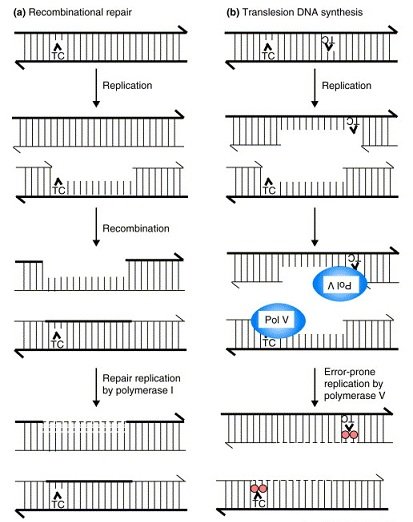Repair Replication
Repair Replication Assignment Help | Repair Replication Homework Help
Repair Replication
The DNA of a cell is subject to damage from a variety of environmental factors like radiation, chemicals, physical stimuli, etc. The survival of the cell depends on its ability to repair this damage. DNA damage is of two general types, monoadduct and diddduct. Monadducts are alterations involving a single nitrogenous base, e.g. the deamination reactions of chemical mutagens like HNO2. Diadducts are alterations involving more than one nitrogenous base.
A variety of nucleases are involved in repair replication. Exonucleases have been defined as phosphodiesterases that require a terminus for hydrolysis. They cut off terminal nucleotides. Endonucleases, on the other hand, are phosphodiesterases that do not require a terminus for hydrolysis. They break internal bonds. Endonucleases specifically acting on damaged DNA resulting in repair or correction of the molecule are called correctional nucleases or correndonucleases. These are further divided into correndonuclease I and correndonuclease II, depending on whether they specify monoadduct or diadduct alterations in DNA.
1. Incision. Damage or distortion of the DNA double helix is recognized by an endonuclease or incision enzyme. This enzyme breaks one of the strands near the damaged point. They incise close to the damaged part of the DNA strand.
2. Excision. The damaged part of the strand is removed by an exonuclease or excision enzyme. DNA polymerase I of E.coli has 3’→5’ exonucleolytic activity. This serves as ‘proofreading’ and ‘edits’ incorrectly incorporated nucleotides. DNA polymerase I also has 5’→3’ exonuclease activity by which thymine dimmers can be excised.

3. Re-insertion. New nucleotides, complementary to those on the intact strand opposite, are inserted by DNA polymerases. Excision insertion pathways may involve polymerase I (short patch repair) or polymerases II and/or III (long patch repair). Most DNA repair takes place in short patches. In E.coli long patch repair requires unwinding protein for polymerization action of polymerase II. Both polymerases II and III appear to be involved in UV-induced repair.
4. Joining of newly formed strand segment. The newly synthesized segment of the DNA strand is linked to the main strand by a joining enzyme polynucleotide ligase.